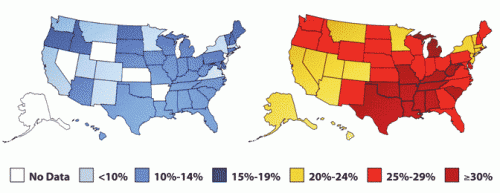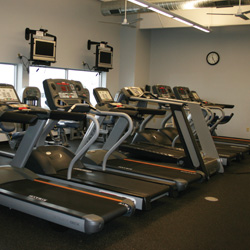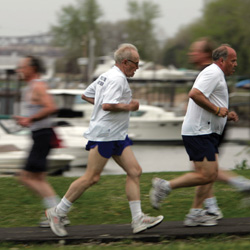Addressing rising healthcare costs and risk factors will require a collaborative, community-wide approach from policymakers, health providers, public organizations and the business community—employers are a large part of the solution.
The map was light blue in 1990. Today, it’s red. These graphics from the Centers for Disease Control and Prevention depict the state-by-state obesity trend in the United States, rising from light blue (less than 10 percent obese) to red (over 30 percent) in just two decades. Four years ago, only one state was above 30 percent.
Something about seeing the epidemic fester on a map in this way—the colors rapidly spreading across the country, as if unstoppable—is rather unsettling.

Illinois is the 24th fattest state in the nation, with about 27 percent of its residents considered obese. But Peoria County statistics are worse than the state average, with more than 30 percent obese, notes the Peoria City/County Health Department in its 2011-2016 Community Health Needs Assessment & Plan (CHNAP). And it’s not just obesity: “Many chronic health conditions and diseases are related to obesity,” the report continues, “including heart disease, diabetes, sleep apnea, hypertension, stroke, high cholesterol and respiratory disease.”
The financial breakdown of our deteriorating health is equally disturbing. A recent study by Indiana University and Purdue University found that poor lifestyle choices accounted for more than 87 percent of healthcare claim costs. For perspective, U.S. healthcare expenditures totaled approximately $2.4 trillion in 2010. In Illinois, adult obesity alone adds about $3.4 billion to healthcare costs each year.
Alarmed by these high costs and risk factors, the CHNAP outlines obesity as one of three regional health risks to target over the next five years. In its strategy, perhaps most complicated is encouraging “collaboration among area medical providers, hospital systems, social service agencies, elected officials, the business community and public health organizations.” As Peoria County Public Health Administrator Greg Chance notes, “We’re not going to be successful addressing these issues as independent entities—we need to have a systems approach.”
A significant part of the solution lies with the business community. In the face of these disturbing trends, many employers are implementing or altering their workplace wellness programs. Though lurking changes to the Patient Protection and Affordable Care Act may impact employers’ incentives to create and maintain active wellness programs, there’s no doubt such programs are improving employees’ health. Along with the obvious moral and health benefits, wellness programs ultimately improve a company’s bottom line as well: healthier employees make for more productive employees.
Business as Usual
“One problem is that there are not a lot of companies that know how to [enact change], and…don’t really understand that it is an investment,” explains Dr. Matt McMillan, medical director of Optimum Health Solutions, a workplace wellness consulting company based in Peoria. “It’s really looking at the long-term benefits—two [to] five years down the road, when they’ll start to reap some of the rewards of putting the wellness program in place…Business owners have to look at wellness as no different than those other necessary functions of conducting business.”
McMillan’s company gathers health data from clients’ employees, identifies their risk factors and presents the assessment back in aggregate form to the company’s administration. Together, they then devise a wellness plan to address health improvement. McMillan breaks it down: “How many individuals in your organization have x number of risk factors? We know the higher number of risk factors that an employee has, the more expensive they are at the end of the day to the company.” He stresses the importance of having wellness programs at the workplace because “that’s where people spend most of their time.”
“As a physician, I’m lucky if I see people once or twice a year for exams, so I have limited influence on what they do…day-to-day,” he says. “That’s a totally different story than companies…If wellness is promoted in the areas where people spend the vast majority of their time, I think that’s where you have your highest likelihood of success.”
Keith Swartzentruber, executive director of Snyder Village, a retirement living community in Metamora, understands the need to promote wellness for his 200 employees. Last January, he implemented a 100% smoke-free policy for all residents and employees on site, introduced insurance premium discounts for employees who don’t smoke and have low BMIs, and started an on-site Weight Watchers program and weekly Zumba fitness class for interested employees.
“I’ve seen studies that say you get somewhere between four and six dollars back for every dollar you invest [in wellness programs],” Swartzentruber says. “Do I completely believe that? No, because I don’t think you can absolutely ‘hard-dollar code’ a lot of this stuff. But I do believe that if employees believe their workplace has their best interests in mind…that makes a difference in the productivity, buy-in and effectiveness…that you get from that employee.”
 A Lei and Then Some
A Lei and Then Some
Peoria-based Maui Jim also provides health insurance premium discounts for its employees—10 percent off for non-smokers and another 10 percent off for those willing to complete a wellness screening. The sunglass company has also sponsored voluntary wellness programs, including the “Slimmest Jim” program in which participants tracked their weight, cholesterol and blood pressure for financial incentives and prizes.
“Our main goal is to keep it fresh and new and varied,” says Rhonda Bessert, vice president of human resources. “We’ve done a variety of different programs over the years focusing on overall health and wellness.”
Maui Jim’s overall approach is, in two words, quite nice. Hula music coos over speakers in the hallways of the sprawling 350-employee facility on Allen Road. Conference rooms boast water views, with two lakes in the front lot, and leis hang from cubicle corners. There’s a new 24/7 fitness center on site and two cardio and circuit fitness trainers offer training and a variety of classes. Free one-on-one consultations are available in a separate series of rooms devoted to the cause. The gym is now also open to employees’ spouses for free.
“We try to hold the classes at various times throughout the day to work with everyone’s schedule,” Bessert explains. “It’s hard to measure success with an actual number, but we’ve had quite a few employees that have physically lost more than 50 pounds. Or, they’ve made drastic improvements to their health score, and they share that with excitement. Overall, [our programs] not only help with our health expenses, but also [with] morale and improved attendance.”
 Though less tropically inclined, Pearl Companies in Peoria Heights has a similar on-site facility, available to all Pearl Insurance, Technology and Automotive employees. Fitness trainers, exercise classes four nights a week and extra break time for those who use the gym, are some of the center’s perks, explains Dorene Burkhalter, senior vice president of human resources. She says the greatest gift an employer can give is to “encourage and try to make exercise convenient for your employees. [To find] a way to have a facility close by to encourage them to go over the lunch break, come in late, or anything to help them squeeze it into their busy lives.”
Though less tropically inclined, Pearl Companies in Peoria Heights has a similar on-site facility, available to all Pearl Insurance, Technology and Automotive employees. Fitness trainers, exercise classes four nights a week and extra break time for those who use the gym, are some of the center’s perks, explains Dorene Burkhalter, senior vice president of human resources. She says the greatest gift an employer can give is to “encourage and try to make exercise convenient for your employees. [To find] a way to have a facility close by to encourage them to go over the lunch break, come in late, or anything to help them squeeze it into their busy lives.”
It doesn’t hurt that Pearl is just blocks from “the world’s most beautiful drive,” as Theodore Roosevelt once declared. “Just knowing that…if I want to, on a beautiful day, I can walk Grandview Drive with my headset on at lunchtime just to get out…” Burkhalter trails. “I exercise every day to get rid of my stress and to just feel good—it’s a habit for me now.”
Smaller Strides Also Effective
Clearly, not every business can afford an on-site exercise facility, a dreamy location, personal trainers and premium discounts. But McMillan says sometimes smaller companies actually allow for more flexibility when creating wellness plans. “In smaller companies where you have some familiarity among the employees, you can do things that are much more challenge-related. There’s a lot more possibility with fun things you can do,” he says.
Bessert recommends smaller companies “start small,” perhaps implementing a walking program “just to get people moving.”
“A lot of the education classes are free of charge…you can bring [them] on site and do lunch-and-learns and things like that,” she says. “We’ve started small, and it’s grown over the years.” Bessert is referring to organizations like the YMCA, American Red Cross, OSF Saint Francis, Methodist Medical Center and the American Cancer Society, which offer a host of wellness programs for employers to utilize.
For example, the American Cancer Society offers free “Active for Life” and “Train-the-Trainer” wellness programs, as well as a consulting tool to interested employers. These programs provide companies with materials to implement smoking cessation and wellness programs on site, or to assess programs they may already have in place.
Kelli Evans, regional director of health initiatives at the American Cancer Society, says, “When people do the necessary testing, they eat right and they’re physically active, it’s going to help all the chronic diseases—not just cancer. We want to make sure people have the access to be healthy, and [we] work with business owners to offset some of those costs so people can afford healthy choices.”
In another collaborative approach, OSF partners with the Peoria Park District to host wellness programs at the RiverPlex Recreation and Fitness Center. These programs correlate with both the wellness services and health screenings offered at the hospital, and with on-site business services, providing what Jo Garrison, director of wellness programs at OSF, calls “integrated healthcare.”
“In the past…we got hung up on screenings, and making sure people didn’t have high blood pressure and high cholesterol,” she explains. “The part that was missing was…if it is high, what do you do about it?” Wellness programming by OSF is now more solution-oriented, utilizing its “multidisciplinary team of exercise specialists, registered nurses, dieticians and physicians,” Garrison says.
To the Beat of the Right Drum
No matter how large or small a company’s steps toward promoting wellness, leadership will always play a large role in its success. “What we find in every company we go into is most armies follow the general into battle,” McMillan says. “Any small business that really wants to look at health absolutely has to start at the top. If the president, CEO or vice presidents are practicing lifestyles that are healthy, the people under them tend to take that example.”
Kelly Davis, manager of employee benefit plans at CliftonLarsonAllen LLP, agrees. She says developing a wellness program is “really about having an understanding of who your workforce is and what’s important to them. It’s going to be different for every company, in different industries and different locations.”
Take Peoria County. In 2008, the county introduced a new employee wellness program called “Live Well,” which includes perks like a $500 annual benefit for employee health plan members, reimbursable fitness club memberships and wellness screenings. But one of the “greatest success stories” thus far, says Shauna Musselman, risk manager and HR specialist at Peoria County, was the one that catered best to its employees: the Live Well Challenge weight loss contests. “Employees have lost over 1,730 pounds in six separate contests!” she exclaims.
Changing Minds
Indeed, personalized incentives may show the greatest success. Philip Lockwood, race director of the Steamboat Classic and president of the Susan G. Komen for the Cure Memorial Affiliate, says it all really boils down to the individual person.
“You can have government agencies at the federal, state and local levels and applaud the county and city for doing what they’re doing, but ultimately, to create that change…people need to understand that somebody else won’t do it for them,” he says. “They have to do it themselves.”
Lockwood has devoted 19 years to developing the internationally renowned Steamboat Classic races. The event’s initial focus was to get active runners out to compete, but over the years, he explains, that has shifted toward coaxing beginners to become physically active. The Building Steam training program blossomed out of this goal, offering new runners access to an 11-week training program to get in shape and ultimately be able to complete the 4K race.
“What Building Steam is about is helping people take that first step out the door, which is normally the most difficult,” Lockwood continues. The Steamboat Classic has grown steadily over the last five years in particular, at an annual average of 10 percent, an increase he attributes to “local organic growth”—people taking that first step out the door.
“Hopefully, people recognize that smoking is bad, and that being obese is bad,” he says. “But in some cases, it’s not that they don’t want to affect change, it’s that they don’t know how. Or maybe they know how, but then the problem is getting around the big BUT. They can put every reason why not to do this in front of why they can or should.”
The Carrot or the Stick
Lockwood has a point. A true systems approach resulting in significant change will also require attention at this individual level—the development of “a social movement to get people physically active, [and] make it become part of the norm,” he says. The real goal is “about motivation and intervention to change one’s lifestyle.”
“People are motivated in different ways—it’s the carrot or the stick. What employers can do comes from the standpoint of education and encouragement, before they revert to ‘the stick.’ Offer ‘the carrot’ first—the means—and provide people some incentives and have fun with it. If you have things that also make [wellness] easy, accessible and visible to them, it starts to take away some of the reasons why one can’t do it.” iBi
Local Wellness Resources
Here are a handful of local resources devoted to encouraging wellness in your workplace—and making it easy to do so.
- The Methodist Wellmobile program promotes healthier living among central Illinois residents. Its free and low-cost services include blood pressure, blood glucose, cholesterol, heart, prostate and spirometry screenings. To learn more, visit mymethodist.net/services/wellness.
- Encourage your employees to register for a local race, or better yet, register your office as a team. Act now: the Susan G. Komen Race for the Cure is May 12th and the Steamboat Classic is June 16th. Encourage beginners to take advantage of training programs like Building Steam, or start an after-work training program of your own. Building Steam starts April 1st; visit steamboatclassic.org/training-programs.
 Greater Peoria is home to three bicycle clubs: the Illinois Valley Wheelm’n, Peoria Bicycle Club, and the Peoria Area Mountain Bike Association. Encourage your employees to join a club or ride their bikes to work. Organize a biweekly office bike ride at lunch or after work for interested employees.
Greater Peoria is home to three bicycle clubs: the Illinois Valley Wheelm’n, Peoria Bicycle Club, and the Peoria Area Mountain Bike Association. Encourage your employees to join a club or ride their bikes to work. Organize a biweekly office bike ride at lunch or after work for interested employees.- The Illinois Valley Striders offers a number of training resources for beginning or advanced runners. See ivs.org for ways to motivate your employees to get active or involved.
- The OSF Weight Loss Centeroffers one-on-one consultations, diet plans, a Healthy Solutions campaign, Biggest Loser contest, dietician-led classes and more to anyone with the need for these services. OSF’s corporate on-site programming includes pre-employment physicals, work comps and fit-for-testing, and several on-site wellness services. For more info, visit osfsaintfrancis.org/services/OutpatientServices/Wellness.
- The YMCA, which been active in the development of the Central Illinois Wellness Council, is working to impact larger neighborhood changes. To learn how your company can get involved working to increase local farmer’s markets or distributing healthy foods to schools, visit peoriaymca.org/pioneering-healthier-communities.
- The American Cancer Society offers several workplace wellness programs and tips to improve your current programs. Visit acsworkplacesolutions.com to find out more.


